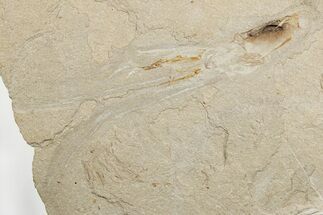This Specimen has been sold.
18.2" Cretaceous Giant Squid Gladius - Kansas
This is a 18.2" long, rachis from an unidentified squid out of the Late Cretaceous, Smoky Hill Chalk in Gove County, Kansas. A gladius, also referred to as the pen, is a rigid rod of chitin within a squid's body that allows for the mantle to retain shape and is composed of two parts. The rachis is the long, slender stem of the gladius that runs almost 3/4 the length of the mantle before it transitions to the flared, arrowhead-shaped vane. This specimen has excellent preservation and is aesthetically prepared within the rock in which it was found. The most common squid fossils coming out of the Smoky Hill Chalk belong to the genus, Tusoteuthis, though a positive identification of this rachis would be purely conjecture.
The surrounding rock was cut flat on the base for ease of display.
The surrounding rock was cut flat on the base for ease of display.
The Smoky Hill Chalk Member of the Niobrara Chalk formation is a Cretaceous conservation Lagerstätte, or fossil-rich geological formation, known primarily for its exceptionally well-preserved marine reptiles. It outcrops in parts of northwest Kansas--its most famous localities for fossils--and in southeastern Nebraska. Large, well-known fossils excavated from the Smoky Hill Chalk include marine reptiles such as plesiosaurs, large bony fish such as Xiphactinus, mosasaurs, pterosaurs, and turtles.
SPECIES
Unidentified Squid
LOCATION
Gove County, Kansas
FORMATION
Smoky Hill Chalk, Niobrara Formation
SIZE
Pen: 18.2" long, Entire Specimen: 20.8 x 6.5"
CATEGORY
ITEM
#208258
We guarantee the authenticity of all of our specimens.
 Reviews
Reviews














